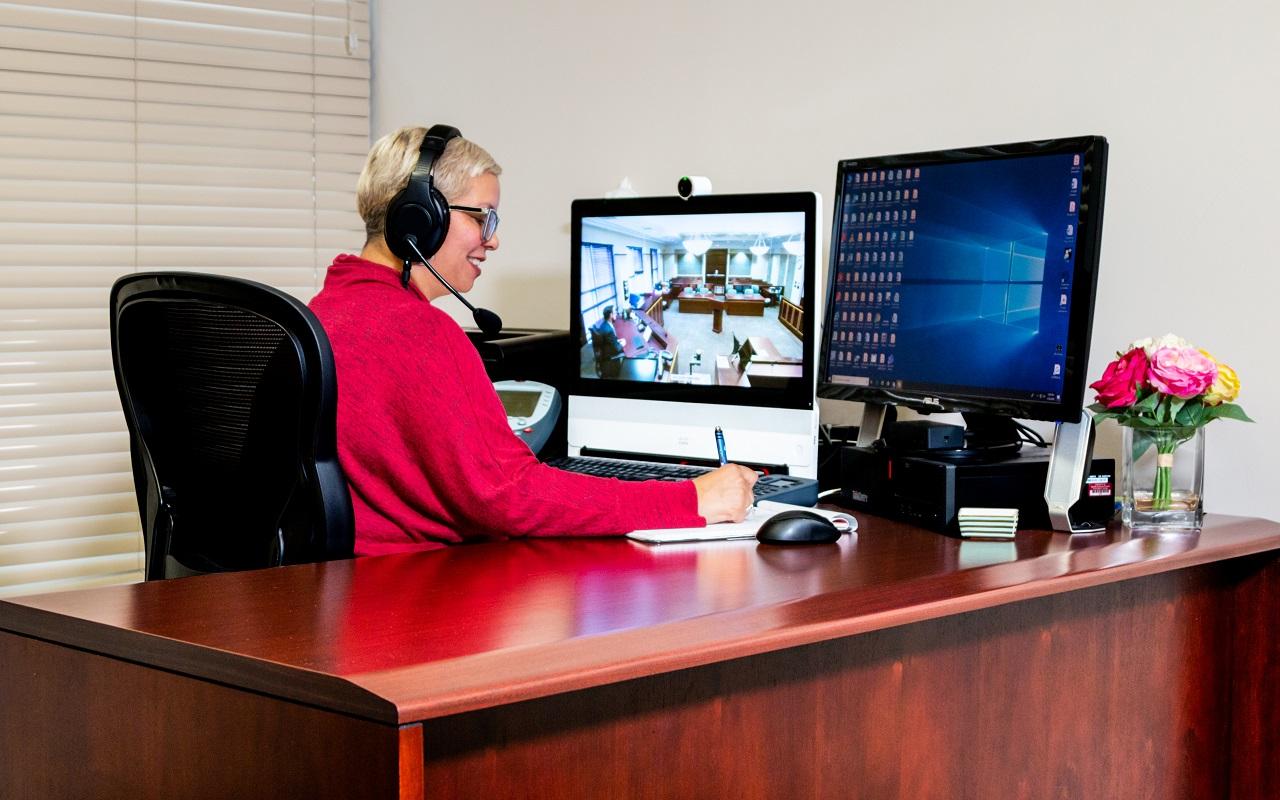Báo song ngữ 107: Phiên dịch từ xa qua video: Cầu nối xóa bỏ rào cản giao tiếp
![]() 18/05/2020 11:16
18/05/2020 11:16
![]() Báo song ngữ
Báo song ngữ

Video remote interpreting: Bridging the communication barrier
With pressure on hospitals to deliver better outcomes and higher patient satisfaction at a lower cost, there is ongoing debate on how to improve the lines of communication between physicians and patients.
Communication can be a challenge when both patient and provider speak the same language, but it's even tougher when they don’t.
Phiên dịch từ xa qua video: Cầu nối xóa tan rào cản giao tiếp
Với việc phải chịu áp lực vừa phải mang lại kết quả chữa trị tốt cho bệnh nhân, vừa phải làm hài lòng khách hàngvới mức chi phí thấp, tại các bệnh viện đang dấy lên tranh luận về vấn đề cải thiện giao tiếp giữa bác sỹ và bệnh nhân.
Giao tiếp giữa bệnh nhân và bác sĩ vốn đã là một thử thách, nhưng khi hai bên không sử dụng cùng một ngôn ngữ thì thách thức càng trở nên lớn hơn bao giờ hết.
"Communication is fundamental to every patient-provider encounter," says James Edwards, CEO of Language Access Network. "Limited English Proficient and deaf and hard of hearing patients simply don't have a level playing field due to language and cultural barriers."
Caring for the increasing diversity of the U.S. population, as well as the rising number of foreign patients seeking care here, is becoming an ever expanding challenge for healthcare providers across the country.
Ông James Edwards, CEO công ty Language Access Network cho rằng: “Giao tiếp đóng vai trò rất quan trọng trong các cuộc thăm khám. Những bệnh nhân có trình độ tiếng Anh hạn chế, bị khiếm thính hoặc tai bị ngễnh ngãng không có môi trường bình đẳng như những bệnh nhân khác do rào cản ngôn ngữ và văn hoá.”
Thành phần dân số Hoa Kỳ ngày một đa dạng cùng số lượng bệnh nhân nước ngoài ngày một tăng đang trở thành thử thách ngày một lớn đối với các đơn vị chăm sóc sức khoẻ toàn quốc.
According to 2014 U.S. Census Bureau data, 21.1 percent of people ages 5 and older speak a language other than English at home. And nearly 9 percent of the U.S. population is at risk for an adverse event because of language barriers, according to the Agency for Healthcare Research and Quality.
Theo dữ liệu năm 2014 của Cục Thống kê Dân số Hoa Kỳ, 21,1% người dân trong độ tuổi từ 5 tuổi trở lên sử dụng một ngoại ngữ khác ngoài tiếng Anh khi ở nhà. Theo Cơ quan Nghiên cứu và Chất lượng Y tế, gần 9% dân số Hoa Kỳ có nguy cơ gặp phải những bất lợi do rào cản ngôn ngữ.
Therefore, hospitals must work even harder today to be prepared for every patient who walks through the door, says Mark Savage, director of health IT policy and programs at the National Partnership for Women & Families, a nonprofit, nonpartisan advocacy group.
Vì thế, các bệnh viện cần nỗ lực hơn để chuẩn bị cho mọi bệnh nhân đến khám, dẫn lời ông Mark Savage, giám đốc Chính sách và Chương trình Công nghệ Y tế tại tổ chức National Partnership for Women & Families (Hiệp hội Đối tác Quốc gia cho Phụ nữ & Gia đình) một tổ chức vận động phi lợi nhuận và đảng phái.
Removing the communication barrier
One-way hospitals are working to prepare for patients and improve lines of communication between physician and patient is through video remote interpreting, an on-demand interpreting service that uses web cameras, videophones and other such devices to provide American Sign Language or spoken language interpreting services.
Xoá bỏ rào cản ngôn ngữ
Một biện pháp bệnh viện đang áp dụng để cải thiện giao tiếp giữa bác sĩ và bệnh nhân đó là sử dụng dịch vụ phiên dịch từ xa. Theo đó dịch vụ phiên dịch từ xa yêu cầu cần có webcam, điện thoại có thể gọi video và một số thiết bị khác để cung cấp dịch vụ dịch ngôn ngữ ký hiệu Hoa Kỳ hoặc dịch nói.
For instance, Children's Hospital of Orange County in Orange, Calif., recently introduced video remote interpreting for healthcare — to its patients and providers.
"We are always striving to bring innovative solutions to our patients," Melanie Patterson, vice president of patient care services and CNO, said in a statement. "We serve a very diverse population, and video medical interpretation has allowed us to increase access to high quality interpreters in a more timely and cost effective fashion."
Ví dụ, tại bệnh viện Nhi đồng quận Cam, California gần đây đã áp dụng dịch vụ phiên dịch video từ xa cho bệnh nhân và bác sĩ. Bà Melanie Patterson, phó chủ tịch dịch vụ chăm sóc bệnh nhân và là giám đốc điều dưỡng tại bệnh viện này cho biết: “Chúng tôi luôn nỗ lực để mang lại những giải pháp sáng tạo cho bệnh nhân của mình. Bệnh nhân tại bệnh viện đến từ rất nhiều nơi khác nhau và phiên dịch từ xa đã giúp chúng tôi tiếp cận với các phiên dịch viên chuyên môn cao với mức phí phải chăng và kịp thời hơn.”
The medical center's video remote interpreting system works in real time, with sound and video, and the patients are able to connect with any of CHOC Children's partner's five U.S.- based language centers where interpreters are available every day, 24 hours a day.
Similarly, Royal Oak, Mich.-based Beaumont Health System, which receives about 65 patients each day whose language is not English, unveiled video remote interpreting four years ago to address the new wave of immigrants who are constantly arriving in the area, according to Mr. Edwards.
Hệ thống phiên dịch từ xa của bệnh viện hoạt động theo thời gian thực làm việc. Với âm thanh và video/hình ảnh, bệnh nhân có thể kết nối bất kỳ với một trong năm trung tâm ngôn ngữ là đối tác của Bệnh viện Nhi đồng quận Cam nơi luôn có phiên dịch viên sẵn sàng 24/7.
Tương tự, bốn năm trước, Bệnh viện Royal Oak, nằm trong hệ thống Y tế Beaumont có trụ sở tại Mich là nơi trung bình mỗi ngày có khoảng 65 bệnh nhân không nói tiếng Anh nhập viện, đã sử dụng phiên dịch từ xa để giải quyết làn sóng người nhập cư liên tục đến khu vực này. Theo chia sẻ của ông Edwards,
"Since we began using a video remote interpreting system, we've significantly reduced wait times for patients needing interpreter services," Patricia Avery, nursing administration information systems coordinator at Beaumont Health System, said in a statement. "This helps reduce anxiety for the patient while allowing caregivers to more quickly assess the patient's medical needs and get care underway."
"Kể từ khi chúng tôi bắt đầu sử dụng hệ thống phiên dịch từ xa, thời gian chờ đợi cho bệnh nhân cần dịch vụ phiên dịch viên được giảm xuống đáng kể". Dẫn lời bà Patricia Avery, điều phối viên hệ thống thông tin quản lý điều dưỡng tại hệ thống Y tế Beaumont: "Hệ thống này giúp giảm nỗi lo lắng cho bệnh nhân đồng thời cho phép người chăm sóc đánh giá nhanh hơn nhu cầu sử dụng dịch vụ y tế của bệnh nhân và từ đó tiến hành chăm sóc cho họ."
The vendors
An array of vendors are providing these services to the healthcare industry, including Cyracom, LAN, InDemand Interpreting and Stratus Video.
Some of these vendors started off providing translation services over the phone, such as Cyracom, which is now offering video remote interpretation services as an add-on to their over-the-phone interpretation business. LAN started off purely doing video over their Martti (My Accessible Real-Time Trusted Interpreter) platform.
Các nhà cung cấp
Hàng loạt các nhà cung cấp dịch vụ này trong ngành chăm sóc sức khỏe, đó là Cyracom, LAN, InDemand Interpreting và Stratus Video.
Một số các nhà cung cấp bắt đầu đưa ra dịch vụ dịch nói qua điện thoại, ví dụ như Cyracom. Công ty này hiện đang cung cấp thêm tiện ích bổ sung là dịch vụ phiên dịch video từ xa cho doanh nghiệp đang sử dụng dịch vụ phiên dịch qua điện thoại. Công ty chuyên cung cấp dịch vụ dịch LAN đã bắt đầu chuyển hoàn toàn sang cung cấp dịch vụ phiên dịch video trên nền tảng Martti (My Accessible Real-Time Trusted Interpreter)
"We didn't start off looking to augment a business already in existence but instead focused on how to give as many health systems and providers as possible access to certified medical interpreters with a superior level of cultural competence," Mr. Edwards says.
Ông Edwards cũng cho biết "Chúng tôi không bắt đầu bằng việc tìm cách thúc đẩy doanh nghiệp đã tồn tại mà thay vào đó tập trung vào cung cấp dịch vụ cho càng nhiều hệ thống y tế và y bác sĩ càng tốt, giúp họ tiếp cận với các phiên dịch viên y tế đã được chứng nhận chuyên môn và mức độ am hiểu văn hóa cao".
Vendors offer these video remote interpreting services for many reasons. One of those reasons is video remote interpreting saves time, according to Mr. Edwards. LAN has found on its network that an audio interpretation is 50 percent longer in terms of number of minutes used than a video interpretation. "There's simply a lot of clarification on the phone that doesn't need to happen in video," Mr. Edwards says.
Theo ông Edwards, một trong những lý do khiến họ bắt đầu cung cấp dịch vụ phiên dịch từ xa là phiên dịch từ xa giúp tiết kiệm rất nhiều thời gian. Hãng LAN đã phát hiện ra rằng một bản dịch âm thanh có số phút dài hơn 50% so với bản dịch video. Ông Edwards chia sẻ cụ thể: "Đơn giản là có rất nhiều điều cần chỉ rõ trên điện thoại nhưng trong video thì không cần giải thích thêm".
He pointed out that an audio interpreter, for instance, can't see somebody clutch their chest when they come to the hospital, discern facial expressions or see what part of the body a provider is pointing to on a clinical model.
Ông chỉ ra rằng giả sử khi phiên dịch chỉ có âm thanh thì ta không thể nhìn thấy bệnh nhân ôm ngực khi họ đến bệnh viện, không thể phân biệt nét mặt hoặc nhìn thấy bộ phận cơ thể khi bác sĩ sử dụng mô hình lâm sang và chỉ vào.
The risks
However, there are risks involved in using interpreter services.
LAN Founder Andy Panos says some interpretation companies, in order to reduce costs and drive down per minute pricing, utilize "off-shore" interpreter resources outside of the United States. This involves patient health information going off-shore, which can lead to HIPAA violations and identity theft. In addition, there is a lack of cultural competency of the interpreter who may have little or no understanding of the U.S. healthcare system, Mr. Panos said.
Những rủi ro
Tuy nhiên, sử dụng dịch vụ phiên dịch vẫn có rủi ro.
Người sáng lập công ty LAN, ông Andy Panos cho biết một số công ty phiên dịch, để giảm chi phí và giảm giá thành mỗi phút đã tận dụng các nguồn lực phiên dịch viên ở nước ngoài. Điều này khiến thông tin sức khỏe của bệnh nhân có thể bị tiết lộ ra nước ngoài, vi phạm luật HIPAA và đánh cắp danh tính. Ngoài ra, theo ông Panos chia sẻ, người phiên dịch có thể thiếu hiểu biết về văn hóa. Họ có thể có ít hoặc không hiểu gì về hệ thống chăm sóc sức khỏe của Hoa Kỳ.
Another risk to be aware of is the use of home based video interpreters, which certain companies use to reduce costs.
Mr. Panos says the audio industry has used this methodology successfully for years, but video brings additional complexities, which make this challenging. These include a lack of quality control of the home environment where a family member or friend may be off-camera, but in the room, the independent contractor status of the home interpreter (restricts the level of training allowed), and the interpreter having little access to proper support.
Một rủi ro khác cần lưu ý là việc sử dụng phiên dịch viên qua video tại nhà. Một số công ty sử dụng phương án này để giảm thiểu chi phí.
Ông Panos nói rằng ngành công nghiệp âm thanh đã thành công trong việc sử dụng phương pháp này trong nhiều năm, nhưng video thì phức tạp hơn, đem lại thử thách lớn hơn. Rủi ro này nằm ở việc thiếu kiểm soát chất lượng môi trường tại nhà bệnh nhân khi một thành viên trong gia đình hoặc bạn bè có thể không lọt vào ống kính nhưng vẫn ở trong phòng, trạng thái ở độc lập của phiên dịch viên tại gia khiến việc đào tạo phiên dịch bị hạn chế và phiên dịch viên có ít được tiếp cận với hỗ trợ phù hợp.
"Delivering high quality video medical interpretation takes a sophisticated and professional approach," Mr. Panos says, "A good language access plan at a hospital will incorporate video as one part of an integrated plan to extend access to language services for its Limited English Proficient and deaf patients."
Ông Panos nhận định: "Việc cung cấp phiên dịch y tế qua video chất lượng cao cần có cách tiếp cận tỉ mỉ và chuyên nghiệp. Để giao tiếp ngôn ngữ ở trong bệnh viện trở nên hiệu quả, cần sử dụng cả phiên dịch qua video như một phần của kế hoạch tích hợp để mở rộng các dịch vụ ngôn ngữ cho bệnh nhân có trình độ tiếng Anh hạn chế và bệnh nhân khiếm thính."
- Báo song ngữ 110: Cách những ngón tay bị chặt đứt có thể mọc trở lại
- Báo song ngữ 109: Mang thai trong thời kỳ đại dịch Corona virus (COVID-19)
- Báo song ngữ 108: Vì sao chúng ta nên suy ngẫm về Việt Nam nhiều hơn?
- Báo song ngữ 106: Phiên dịch Từ xa hay Phiên dịch Trực tiếp - Phiên dịch có tác động như thế nào đến mức độ hài lòng của bệnh nhân
- Báo song ngữ 105: Góc nhìn đại dịch: Toàn cảnh thế giới





![[BÍ KÍP NGHỀ DỊCH] Phương pháp dịch 03: Dịch nguyên văn](https://saokhue.edu.vn/mediacenter/media/images/1478/news/ava/s200_200/artboard-1-1588832349.png)



